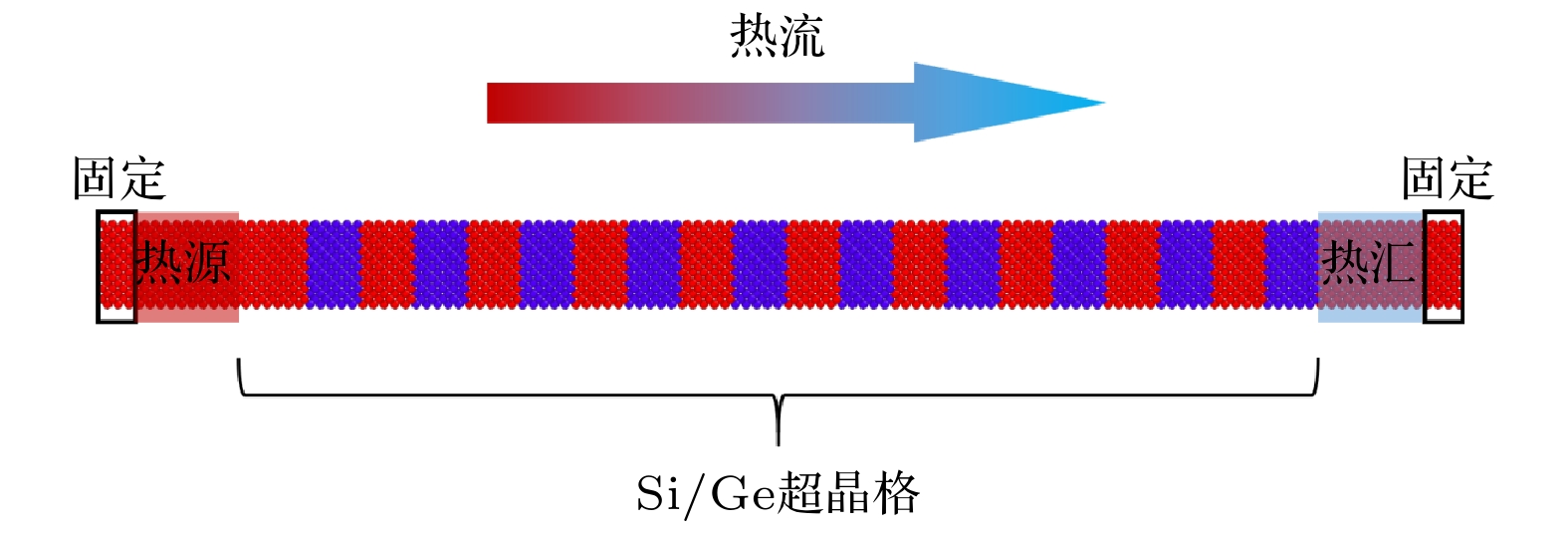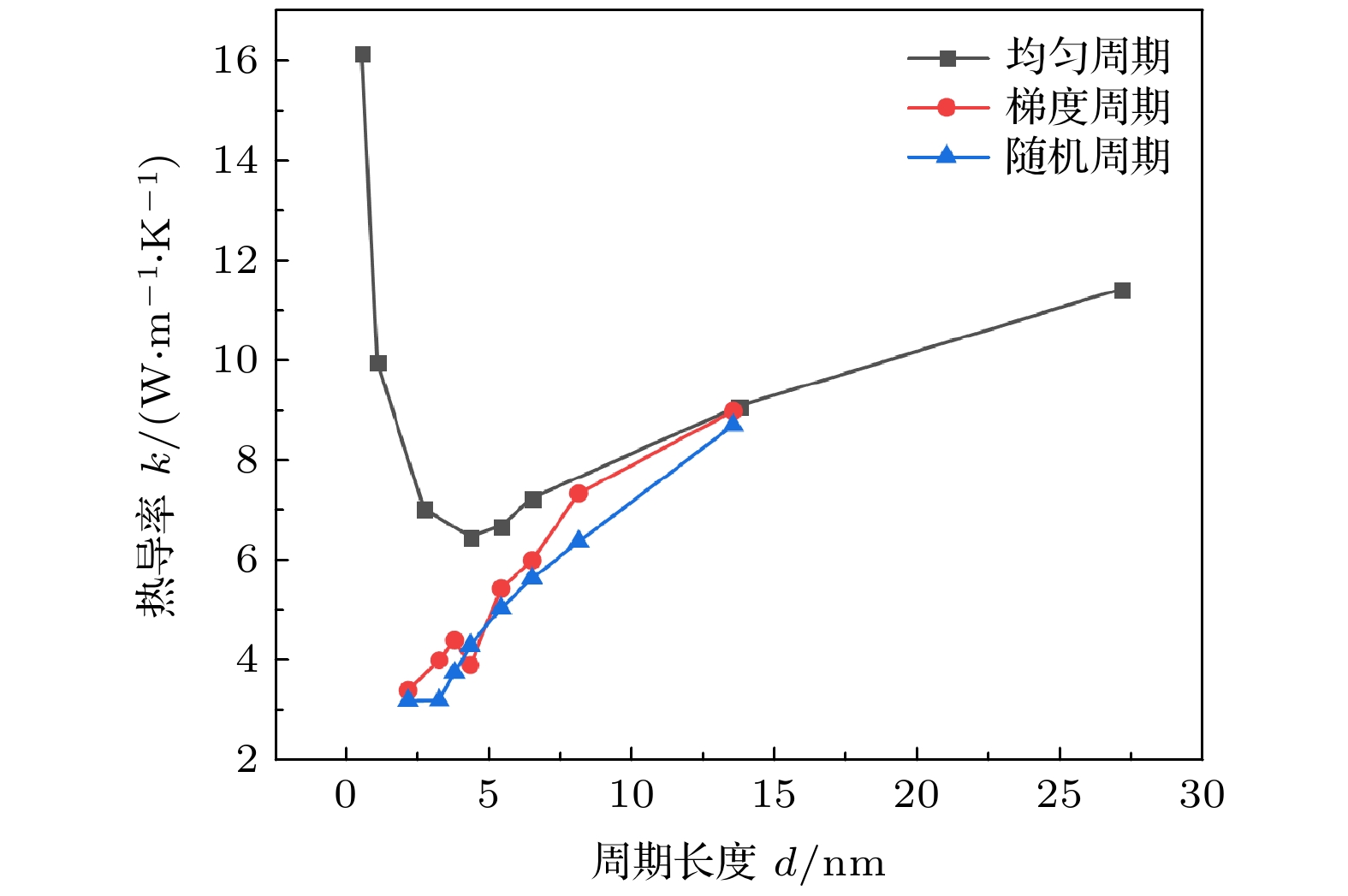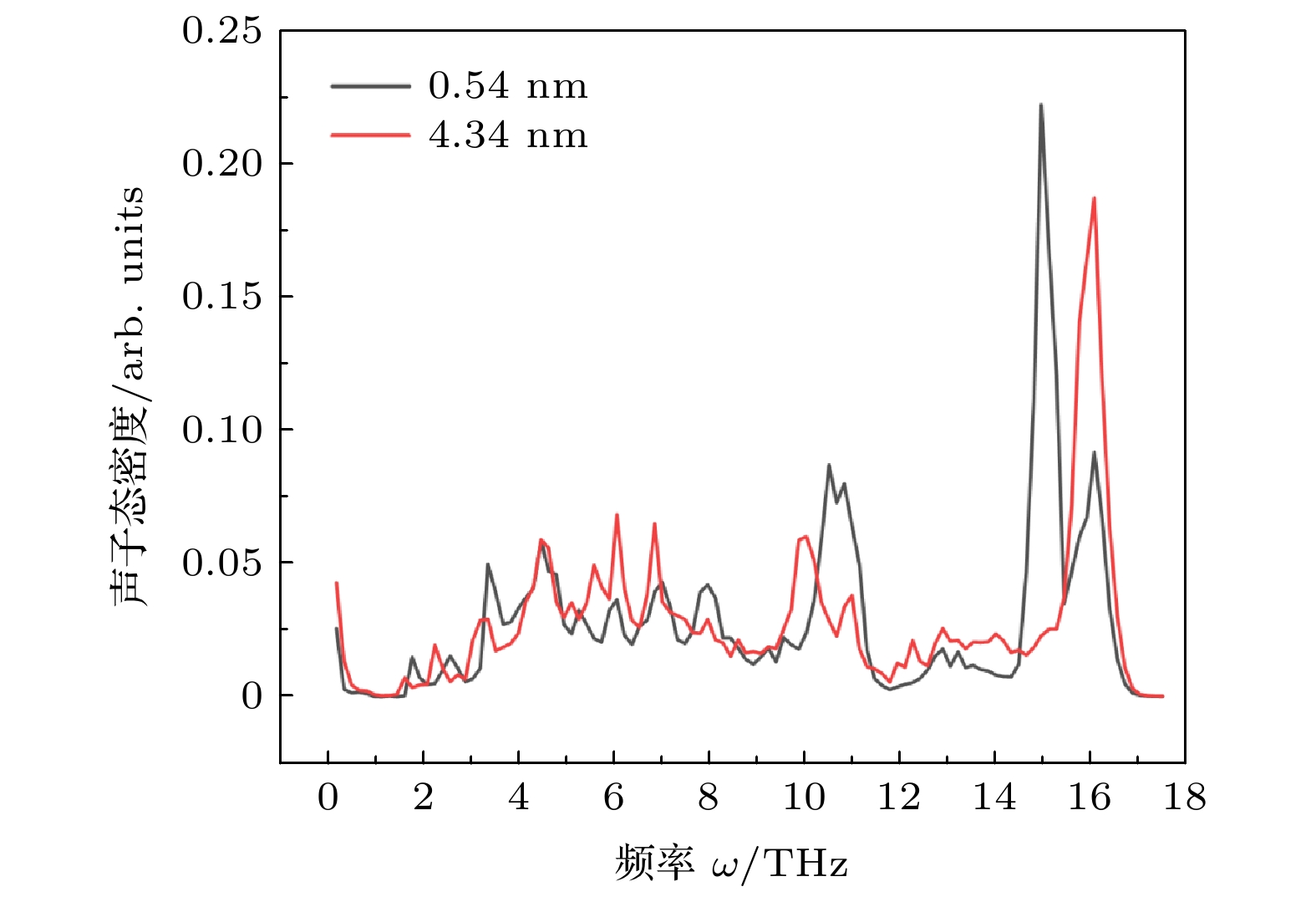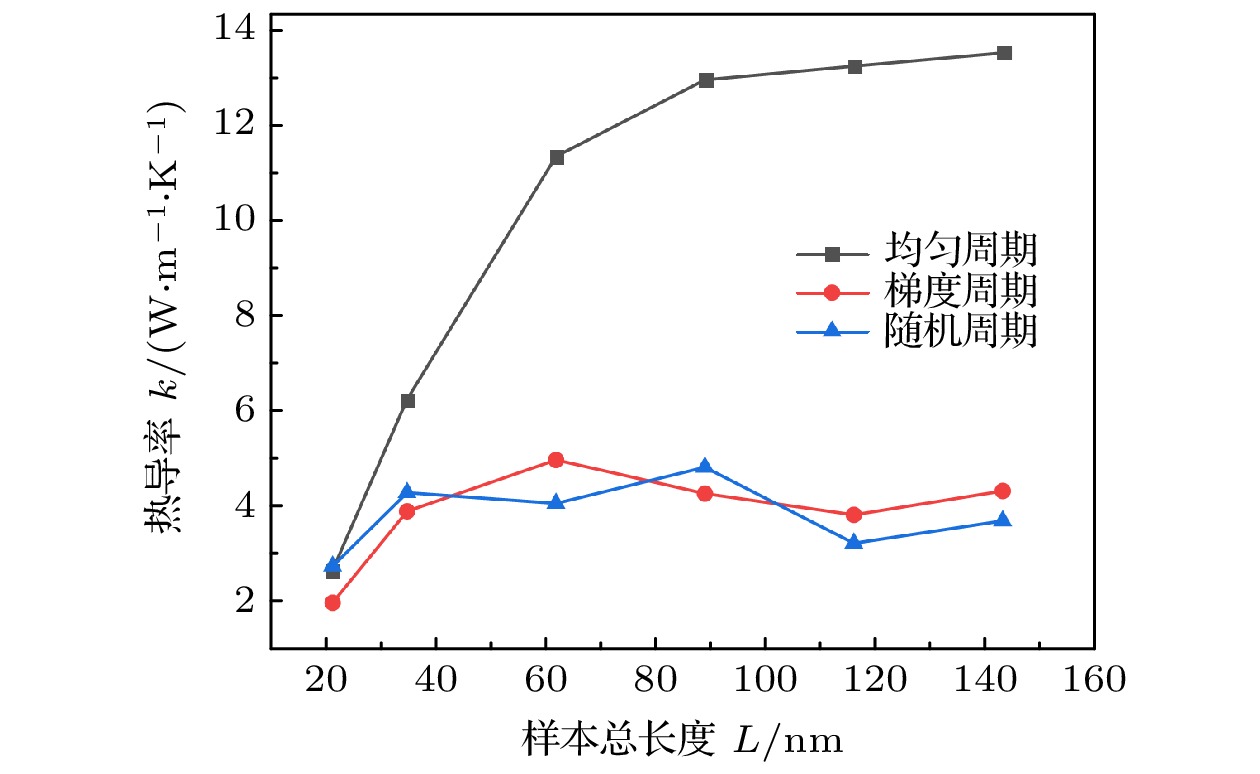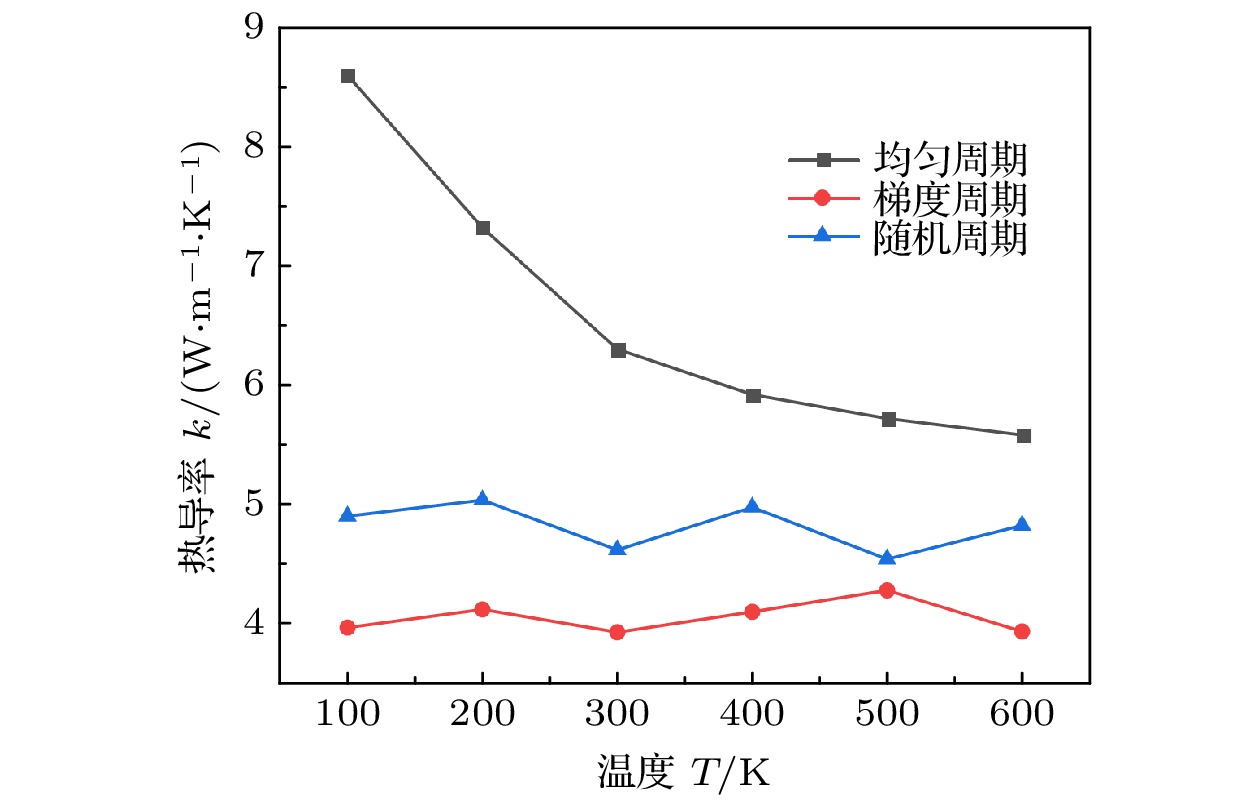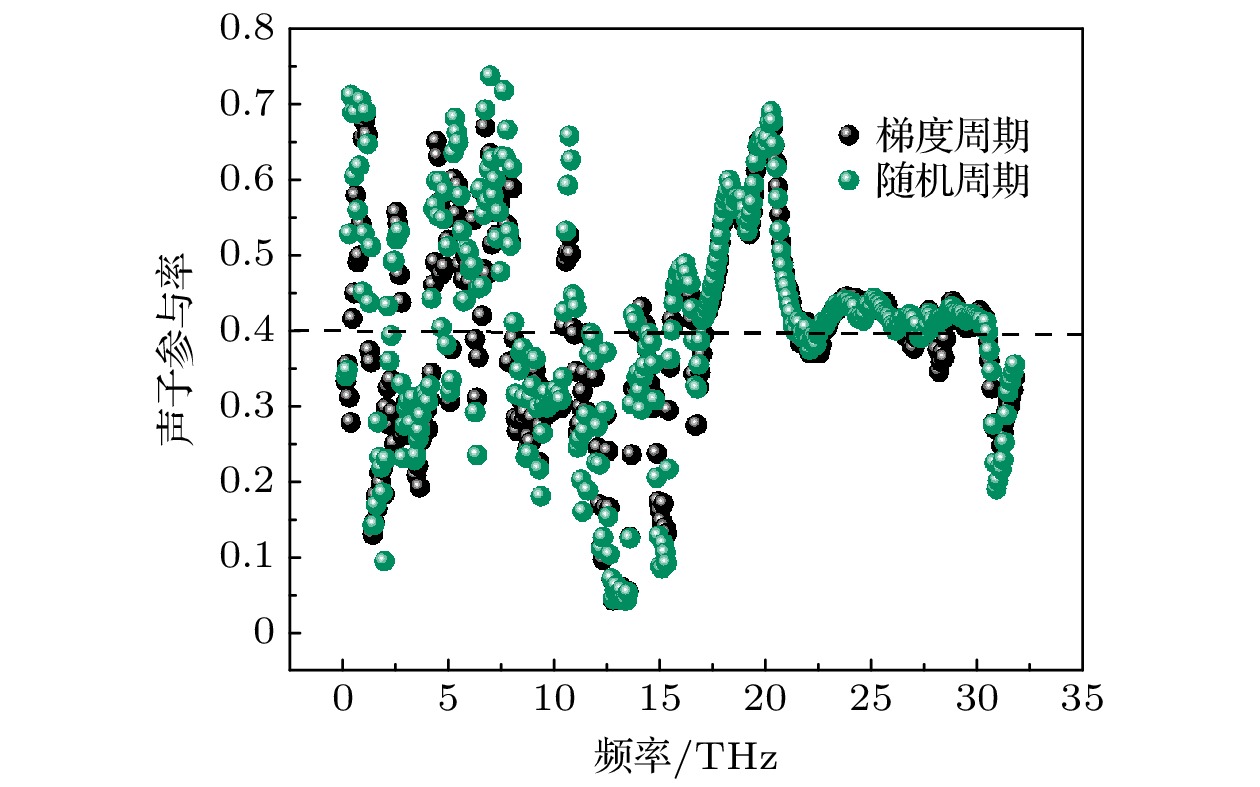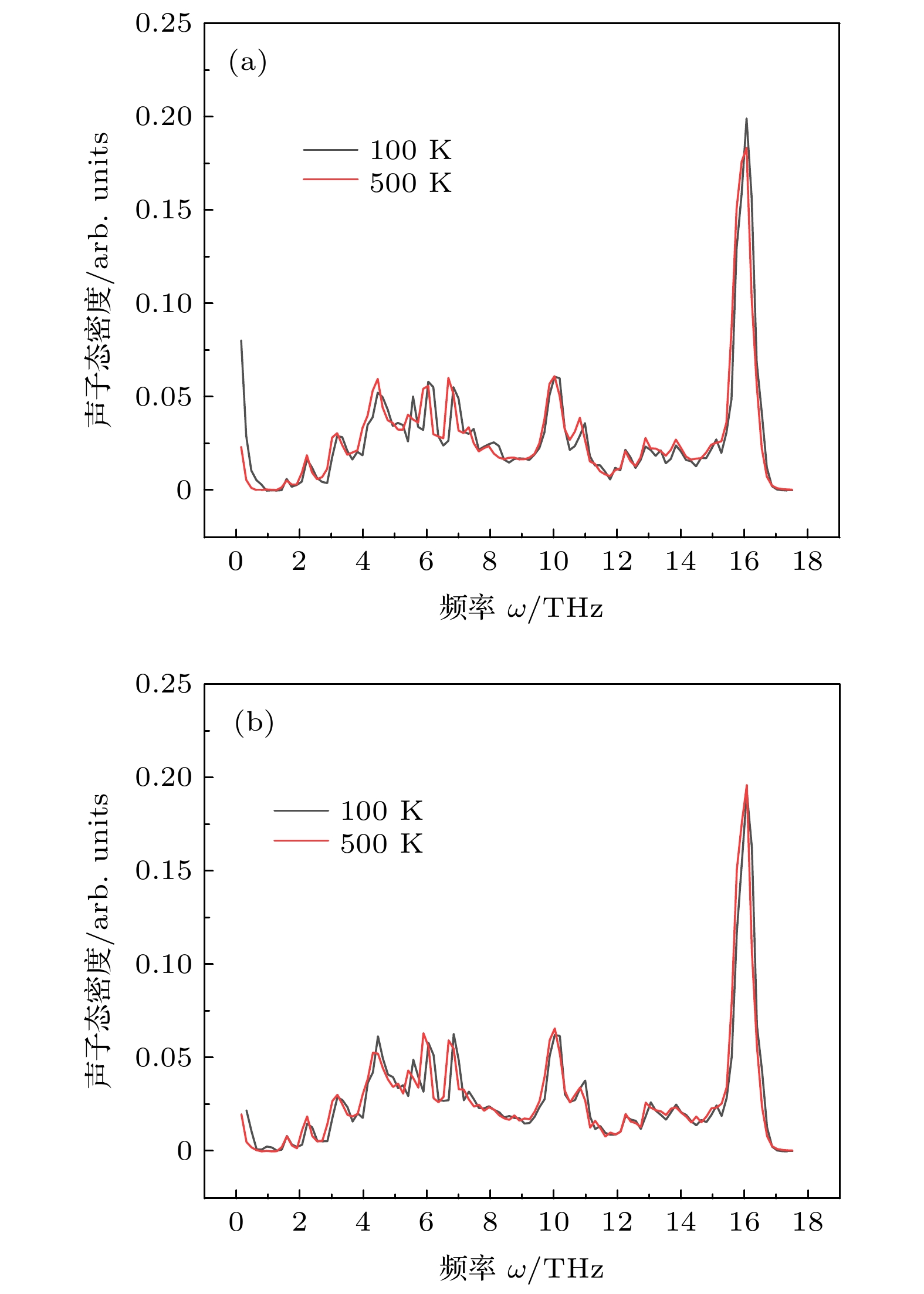-
Thermoelectric materials, which can convert wasted heat into electricity, have attracted considerable attention because they provide a solution to energy problems. The Si/Ge superlattices have shown tremendous promise as effective thermoelectric materials. The period lengths of the Si/Ge superlattices can effectively tailor the phonon's transport behaviors and control their thermal conductivities. In this paper, three kinds of Si/Ge superlattices with different period length distributions (uniform, gradient, random) are constructed. The non-equilibrium molecular dynamics (NEMD) method is used to calculate the thermal conductivities of Si/Ge superlattices under the different period length distributions. The effect of the sample’s total length and temperature on the superlattice's thermal conductivity are studied. The simulation result shows that the thermal conductivity of gradient and random periodical Si/Ge superlattices are significantly reduced at room temperature compared with that of the uniform period Si/Ge superlattices. Phonons are transported by wave or particle properties in the different periodical superlattices. The thermal conductivity of uniform period superlattices has an obvious size effect with the increasing of the sample total length. In contrast, the thermal conductivity of gradient, random periodical Si/Ge superlattices are weakly dependent on the sample’s total length. At the same time, temperature is an important factor affecting the heat transport properties. We find that the temperature affects the thermal conductivities of the three kinds of superlattices in different ways. With the increase of the temperature, (i) the thermal conductivity of uniform periodical superlattices shows an obvious temperature effect; (ii) the thermal conductivity of the gradient and random periodical Si/Ge superlattices are nearly unchanged due to the competition between phonon localization weakness and phonon-phonon scattering enhancement. In addition, the phonon densities of states of superlattices with three different periodical length distributions are calculated. We find that in the picture of uniform periodical Si/Ge superlattices, the number of pronounced peaks quickly decreases as the period length increases, particularly at higher frequencies. This indicates that as the period length increases, fewer coherent phonons will be formed over the superlattices. Moreover, the scattering mechanisms of phonons for gradient and random periodical Si/Ge superlattices are basically the same at 100 K and 500 K. These findings provide a developmental way to further reduce the thermal conductivity of superlattices.
-
Keywords:
- superlattice /
- phonon /
- period length distribution /
- thermal conductivity
[1] Martín-González M, Caballero-Calero O, Díaz-Chao P 2013 Renew. Sust. Energ. Rev. 24 288
 Google Scholar
Google Scholar
[2] Feng T L, Ruan X L, Ye Z, Cao B 2015 Phys. Rev. B 91 224301
 Google Scholar
Google Scholar
[3] Chen Z Y, Wang R F, Wang G Y, Zhou X Y, Wang Z S, Yin C, Hu Q, Zhou B Q, Tang J, Anag R 2018 Chin. Phys. B 27 047202
 Google Scholar
Google Scholar
[4] Wang K X, Wang J, Li Y, Zou T, Wang X H, Li J B, Cao Z, Shi W J, Xinba Y E 2018 Chin. Phys. B 27 048401
 Google Scholar
Google Scholar
[5] 郭敬云, 陈少平, 樊文浩, 王雅宁, 吴玉程 2020 物理学报 69 146801
 Google Scholar
Google Scholar
Guo J Y, Chen S P, Fan W H, Wang Y N, Wu Y C 2020 Acta. Phys. Sin. 69 146801
 Google Scholar
Google Scholar
[6] 张玉, 吴立华, 曾李骄开, 刘叶烽, 张继业, 邢娟娟, 骆军 2016 物理学报 65 107201
 Google Scholar
Google Scholar
Zhang Y, Wu L H, Zengli J K, Liu Y F, Zhang J Y, Xing J J, Luo J 2016 Acta. Phys. Sin 65 107201
 Google Scholar
Google Scholar
[7] Lin K H, Strachan A 2013 Phys. Rev. B 87 115302
 Google Scholar
Google Scholar
[8] Chen Y F, Li D Y, Lukes J R, Ni Z H, Chen M H 2005 Phys. Rev. B 72 174302
 Google Scholar
Google Scholar
[9] Giri A, Hopkins P E, Wessel J G, Duda J C 2015 J. Appl. Phys. 118 165303
 Google Scholar
Google Scholar
[10] Zhou K K, Xu N, Xie G F 2018 Chin. Phys. B 27 026501
 Google Scholar
Google Scholar
[11] Xiong R, Yang C, Wang Q, Zhang Y, Li X 2019 Int. J. Thermophys. 40 86
 Google Scholar
Google Scholar
[12] Zhang C W, Zhou H, Zeng Y, Zheng L, Zhan Y L, Bi K D 2019 Int. J. Heat Mass Transf. 132 681
 Google Scholar
Google Scholar
[13] Samaraweera N, Larkin J M, Chan K L, Mithraratne K 2018 J. Appl. Phys. 123 244303
 Google Scholar
Google Scholar
[14] Juntunen T, Vanska O, Tittonen I 2019 Phys. Rev. Lett. 122 105901
 Google Scholar
Google Scholar
[15] Wang Y, Huang H X, Ruan X L 2014 Phys. Rev. B 90 165406
 Google Scholar
Google Scholar
[16] Plimpton S 1995 J. Comput. Phys. 117 1
 Google Scholar
Google Scholar
[17] Dickey J M, Paskin A 1969 Phys. Rev. 188 1407
 Google Scholar
Google Scholar
[18] Xie G F, Ding D, Zhang G 2018 Adv. Phys.-X 3 1480417
 Google Scholar
Google Scholar
[19] Ravichandran J, Yadav A K, Cheaito R, Rossen P B, Soukiassian A, Suresha S J, Duda J C, Foley B M, Lee C-H, Zhu Y, Lichtenberger A W, Moore J E, Muller D A, Schlom D G, Hopkins P E, Majumdar A, Ramesh R, Zurbuchen M A 2014 Nat. Mater. 13 168
 Google Scholar
Google Scholar
[20] Simkin M V, Mahan G D 2000 Phys. Rev. Lett. 84 927
 Google Scholar
Google Scholar
[21] Maldovan M 2015 Nat. Mater. 14 667
 Google Scholar
Google Scholar
[22] Chernatynskiy A, Grimes R W, Zurbuchen M A, Clarke D R, Phillpot S R 2009 Appl. Phys. Lett. 95 161906
 Google Scholar
Google Scholar
[23] Chen X K, Xie Z X, Zhou W X, Tang L M, Chen K Q 2016 Appl. Phys. Lett. 109 023101
 Google Scholar
Google Scholar
[24] Luckyanova M N, Mendoza J, Lu H, Song B, Huang S, Zhou J, Li M, Dong Y, Zhou H, Garlow J, Wu L, Kirby B J, Grutter A J, Puretzky A A, Zhu Y, Dresselhaus M S, Gossard A, Chen G 2018 Sci. Adv. 338 936
 Google Scholar
Google Scholar
[25] Schelling P K, Phillpot S R, Keblinski P 2002 Phys. Rev. B 65 144306
 Google Scholar
Google Scholar
[26] 刘英光, 边永庆, 韩中合 2020 物理学报 69 033101
 Google Scholar
Google Scholar
Liu Y G, Bian Y Q, Han Z H 2020 Acta. Phys. Sin. 69 033101
 Google Scholar
Google Scholar
[27] Chen J, Zhang G, Li B W 2010 Nano Lett. 10 3978
 Google Scholar
Google Scholar
[28] Liang T, Zhou M, Zhang P, Yuan P, Yang D G 2020 Int. J. Heat Mass Transf. 151 119395
 Google Scholar
Google Scholar
[29] Zhang Z W, Chen Y P, Xie Y, Zhang S B 2016 Appl. Therm. Eng. 102 1075
 Google Scholar
Google Scholar
[30] Wang Y, Vallabhaneni A, Hu J, Qiu B, Chen Y P, Ruan X L 2014 Nano Lett. 14 592
 Google Scholar
Google Scholar
[31] Bodapati A, Schelling P K, Phillpot S R, Keblinski P 2006 Phys. Rev. B 74 245207
 Google Scholar
Google Scholar
-
-
[1] Martín-González M, Caballero-Calero O, Díaz-Chao P 2013 Renew. Sust. Energ. Rev. 24 288
 Google Scholar
Google Scholar
[2] Feng T L, Ruan X L, Ye Z, Cao B 2015 Phys. Rev. B 91 224301
 Google Scholar
Google Scholar
[3] Chen Z Y, Wang R F, Wang G Y, Zhou X Y, Wang Z S, Yin C, Hu Q, Zhou B Q, Tang J, Anag R 2018 Chin. Phys. B 27 047202
 Google Scholar
Google Scholar
[4] Wang K X, Wang J, Li Y, Zou T, Wang X H, Li J B, Cao Z, Shi W J, Xinba Y E 2018 Chin. Phys. B 27 048401
 Google Scholar
Google Scholar
[5] 郭敬云, 陈少平, 樊文浩, 王雅宁, 吴玉程 2020 物理学报 69 146801
 Google Scholar
Google Scholar
Guo J Y, Chen S P, Fan W H, Wang Y N, Wu Y C 2020 Acta. Phys. Sin. 69 146801
 Google Scholar
Google Scholar
[6] 张玉, 吴立华, 曾李骄开, 刘叶烽, 张继业, 邢娟娟, 骆军 2016 物理学报 65 107201
 Google Scholar
Google Scholar
Zhang Y, Wu L H, Zengli J K, Liu Y F, Zhang J Y, Xing J J, Luo J 2016 Acta. Phys. Sin 65 107201
 Google Scholar
Google Scholar
[7] Lin K H, Strachan A 2013 Phys. Rev. B 87 115302
 Google Scholar
Google Scholar
[8] Chen Y F, Li D Y, Lukes J R, Ni Z H, Chen M H 2005 Phys. Rev. B 72 174302
 Google Scholar
Google Scholar
[9] Giri A, Hopkins P E, Wessel J G, Duda J C 2015 J. Appl. Phys. 118 165303
 Google Scholar
Google Scholar
[10] Zhou K K, Xu N, Xie G F 2018 Chin. Phys. B 27 026501
 Google Scholar
Google Scholar
[11] Xiong R, Yang C, Wang Q, Zhang Y, Li X 2019 Int. J. Thermophys. 40 86
 Google Scholar
Google Scholar
[12] Zhang C W, Zhou H, Zeng Y, Zheng L, Zhan Y L, Bi K D 2019 Int. J. Heat Mass Transf. 132 681
 Google Scholar
Google Scholar
[13] Samaraweera N, Larkin J M, Chan K L, Mithraratne K 2018 J. Appl. Phys. 123 244303
 Google Scholar
Google Scholar
[14] Juntunen T, Vanska O, Tittonen I 2019 Phys. Rev. Lett. 122 105901
 Google Scholar
Google Scholar
[15] Wang Y, Huang H X, Ruan X L 2014 Phys. Rev. B 90 165406
 Google Scholar
Google Scholar
[16] Plimpton S 1995 J. Comput. Phys. 117 1
 Google Scholar
Google Scholar
[17] Dickey J M, Paskin A 1969 Phys. Rev. 188 1407
 Google Scholar
Google Scholar
[18] Xie G F, Ding D, Zhang G 2018 Adv. Phys.-X 3 1480417
 Google Scholar
Google Scholar
[19] Ravichandran J, Yadav A K, Cheaito R, Rossen P B, Soukiassian A, Suresha S J, Duda J C, Foley B M, Lee C-H, Zhu Y, Lichtenberger A W, Moore J E, Muller D A, Schlom D G, Hopkins P E, Majumdar A, Ramesh R, Zurbuchen M A 2014 Nat. Mater. 13 168
 Google Scholar
Google Scholar
[20] Simkin M V, Mahan G D 2000 Phys. Rev. Lett. 84 927
 Google Scholar
Google Scholar
[21] Maldovan M 2015 Nat. Mater. 14 667
 Google Scholar
Google Scholar
[22] Chernatynskiy A, Grimes R W, Zurbuchen M A, Clarke D R, Phillpot S R 2009 Appl. Phys. Lett. 95 161906
 Google Scholar
Google Scholar
[23] Chen X K, Xie Z X, Zhou W X, Tang L M, Chen K Q 2016 Appl. Phys. Lett. 109 023101
 Google Scholar
Google Scholar
[24] Luckyanova M N, Mendoza J, Lu H, Song B, Huang S, Zhou J, Li M, Dong Y, Zhou H, Garlow J, Wu L, Kirby B J, Grutter A J, Puretzky A A, Zhu Y, Dresselhaus M S, Gossard A, Chen G 2018 Sci. Adv. 338 936
 Google Scholar
Google Scholar
[25] Schelling P K, Phillpot S R, Keblinski P 2002 Phys. Rev. B 65 144306
 Google Scholar
Google Scholar
[26] 刘英光, 边永庆, 韩中合 2020 物理学报 69 033101
 Google Scholar
Google Scholar
Liu Y G, Bian Y Q, Han Z H 2020 Acta. Phys. Sin. 69 033101
 Google Scholar
Google Scholar
[27] Chen J, Zhang G, Li B W 2010 Nano Lett. 10 3978
 Google Scholar
Google Scholar
[28] Liang T, Zhou M, Zhang P, Yuan P, Yang D G 2020 Int. J. Heat Mass Transf. 151 119395
 Google Scholar
Google Scholar
[29] Zhang Z W, Chen Y P, Xie Y, Zhang S B 2016 Appl. Therm. Eng. 102 1075
 Google Scholar
Google Scholar
[30] Wang Y, Vallabhaneni A, Hu J, Qiu B, Chen Y P, Ruan X L 2014 Nano Lett. 14 592
 Google Scholar
Google Scholar
[31] Bodapati A, Schelling P K, Phillpot S R, Keblinski P 2006 Phys. Rev. B 74 245207
 Google Scholar
Google Scholar
Catalog
Metrics
- Abstract views: 9803
- PDF Downloads: 183
- Cited By: 0














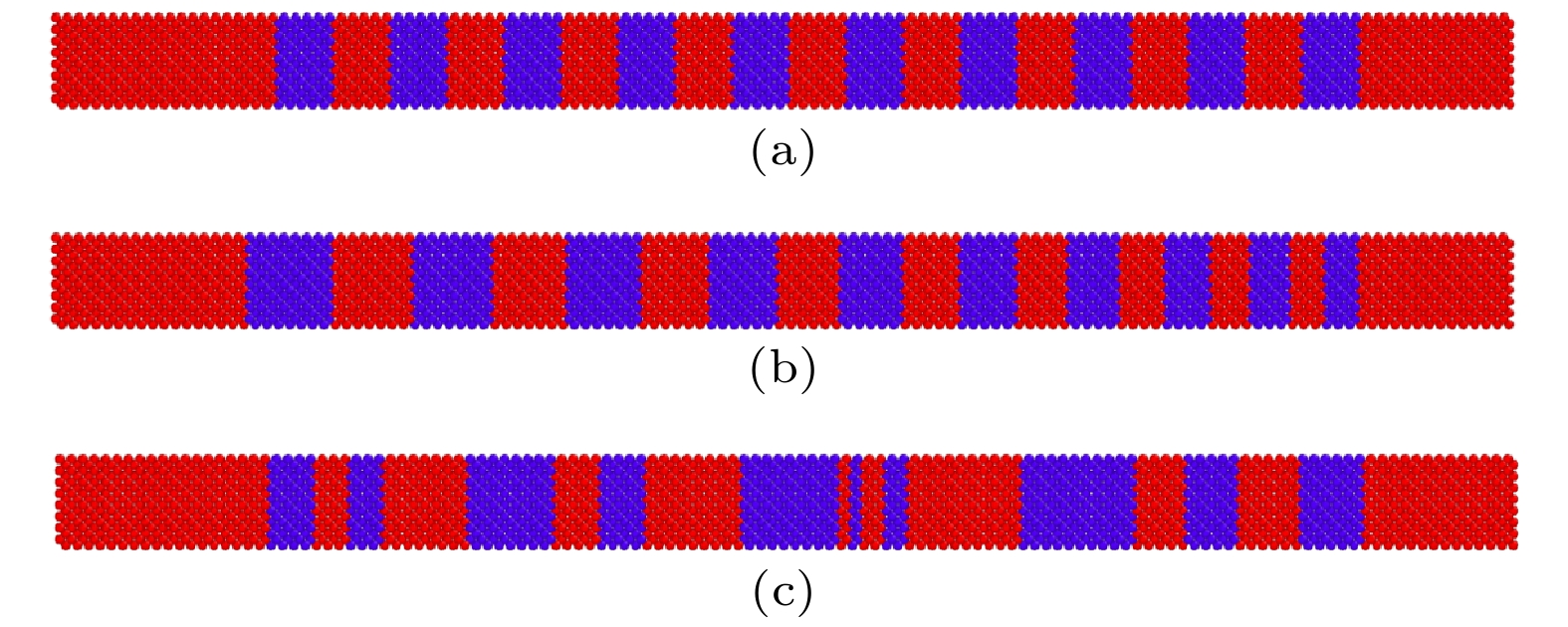
 DownLoad:
DownLoad:
